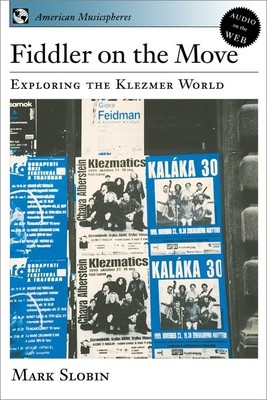
- We will send in 10–14 business days.
- Author: Mark Slobin
- Publisher: Oxford University Press, USA
- ISBN-10: 0195161807
- ISBN-13: 9780195161809
- Format: 15.4 x 23.6 x 1.3 cm, minkšti viršeliai
- Language: English
- SAVE -10% with code: EXTRA
Reviews
Description
"Klezmer" is a Yiddish word for professional folk instrumentalist-the flutist, fiddler, and bass player that made brides weep and guests dance at weddings throughout Jewish eastern Europe before the culture was destroyed in the Holocaust, silenced under Stalin, and lost out to assimilation in America. Klezmer music is now experiencing a tremendous new spurt of interest worldwide with both Jews and non-Jews recreating this restless volatile, and vibrant musical culture. Firmly centered in the United States, klezmer has paradoxically moved back across the Atlantic as a distinctly "American" music, played throughout central and eastern Europe, as well as in many other parts of the world.
Fiddler on the Move places klezmer music squarely within American music studies, cultural studies, and ethnomusicology. Neither a chronology nor a comprehensive survey, the book describes a variety of approaches and perspectives for coming to terms with the highly diverse array of activities found under the klezmer umbrella. Bringing to his subject the insights of an accomplished ethnomusicologist, Slobin addresses such questions as: How does klezmer overlap with, and differ from, the many other contemporary "heritage" musics based on an assumed connection with a group identity and links to a tradition? How do economics, artistic expression, and the evocation of the past interact in motivating klezmer performers and audiences? In what kinds of environment does klezmer flourish? How do stylistic features such as genre, form, and ornamentation help to define the technique, affect, and aesthetic of klezmer? Featuring a music CD with many of the archival and contemporary recordings
discussed in the text, this fascinating study will interest scholars, students, musicians, and music lovers
EXTRA 10 % discount with code: EXTRA
The promotion ends in 22d.21:19:53
The discount code is valid when purchasing from 10 €. Discounts do not stack.
- Author: Mark Slobin
- Publisher: Oxford University Press, USA
- ISBN-10: 0195161807
- ISBN-13: 9780195161809
- Format: 15.4 x 23.6 x 1.3 cm, minkšti viršeliai
- Language: English English
"Klezmer" is a Yiddish word for professional folk instrumentalist-the flutist, fiddler, and bass player that made brides weep and guests dance at weddings throughout Jewish eastern Europe before the culture was destroyed in the Holocaust, silenced under Stalin, and lost out to assimilation in America. Klezmer music is now experiencing a tremendous new spurt of interest worldwide with both Jews and non-Jews recreating this restless volatile, and vibrant musical culture. Firmly centered in the United States, klezmer has paradoxically moved back across the Atlantic as a distinctly "American" music, played throughout central and eastern Europe, as well as in many other parts of the world.
Fiddler on the Move places klezmer music squarely within American music studies, cultural studies, and ethnomusicology. Neither a chronology nor a comprehensive survey, the book describes a variety of approaches and perspectives for coming to terms with the highly diverse array of activities found under the klezmer umbrella. Bringing to his subject the insights of an accomplished ethnomusicologist, Slobin addresses such questions as: How does klezmer overlap with, and differ from, the many other contemporary "heritage" musics based on an assumed connection with a group identity and links to a tradition? How do economics, artistic expression, and the evocation of the past interact in motivating klezmer performers and audiences? In what kinds of environment does klezmer flourish? How do stylistic features such as genre, form, and ornamentation help to define the technique, affect, and aesthetic of klezmer? Featuring a music CD with many of the archival and contemporary recordings
discussed in the text, this fascinating study will interest scholars, students, musicians, and music lovers


Reviews